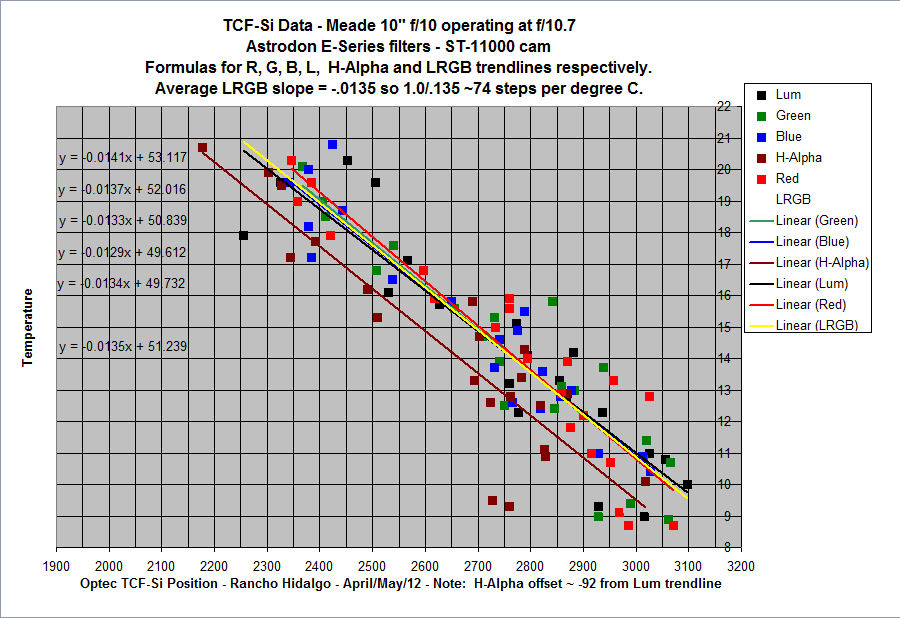Equipment and description of some of the techniques I am using for image capture
Hardware
I am using the following equipment as my primary imaging hardware:
- Meade LX-200 10" f/10 "classic" telescope. (I fully understand it and would be reluctant to change...)
- SBIG STL-11000M camera
containing two chips, the imaging chip and the guide chip.
- KAI-11000M imaging chip
- 36.1 x 24.7 mm (like 35 mm film size!)
- 4008 x 2745 pixel array (11 million pixels)
- 9 x 9 micron pixel size
- Can be binned 1, 2, 3 or 4 (I usually use bin 2 for L and bin 4 for RGB)
- TC237H guide chip
- 4.9 x 3.7 mm
- 657 x 495 pixels (325,000 pixels)
- 7.4 x 7.4 micron pixel size
- KAI-11000M imaging chip
- TCF-si focuser from Optec
- Temperature compensated focuser with 7000 steps
- I collected data using Visual Basic software I wrote to cause Maxim DL Pro 5 to use the guide chip to take images of a star and determine the focus position and record the temperature for each focus point. Atmospheric conditions require LOTS of data points to determine the real focus position versus temperature coefficient because the data is a bit scattered as can easily be seen in the chart below. (Note, if I change anything in the camera train like install a focal reducer or anything else that changes the focal plane, I would have to do that calibration all over again.) Here is the chart that I derived for my current setup:

I created this chart in the eXcel spreadsheet program. It also automatically provides the equations for the lines from which the coefficients needed for the TCF-si focuser can be derived. The coefficient I needed for use with the TCF-si focuser turns out to be 74 steps per degree C. Note that my Astrodon E-Series filters (LRGB) are essentially parfocal. My H-alpha filter is by a different manufacturer so it needs an offset. Probably it is of a different thickness and Snell's law comes into play. You can see that the H-Alpha offset is ~ -92 from the Luminance trendline. There is a place in the Maxim DL camera setup panel that allows filter offsets to be entered. Here is what my offset table looks like currently:
OFFSET TABLE HERE
- Astrodon E-Series LRGB filters. Parfocal near as I can tell from my chart. Hydrogen-Alpha filter obtained from a different source.
- Durango Skies 8" steel piers 47" high.
- Thermaltake Bigwater 760 Plus CPU cooler - CLW0211 for cooling STL-11000M camera. Allows me to maintain -10 C camera chip temperature even in the summertime.
- Foster AMC-100(V)2 roll-off roof control board.
- Foster AMC-101 Weather Monitor
- Foster anemometer
Software
- Maxim DL Pro 5 camera control and initial image processing and stacking.
- ACP observatory control system.
- Photoshop for image processing.
- Paint Shop Pro for image processing.
- HandyAvi for meteor capture. Also telescope control when ACP cannot do the job. etc.
- "GetFocuserData11K.vbs" VBS script to make Maxim DL collect data for TCF-si focuser calibration.
- "ComputeFocus.vbs" C++ software I wrote to make it easy to handle filter offsets and initial setting.
- "FixBadPixels.vbs" - Visual Basic script I wrote to make Maxim DL do automatic calibration of raw images and automatic removal of hot and cold pixels of all images in a selected directory. I use this immediately after every imaging session.
- "SetParkMeade.vbs" and "SetParkCelestron.vbs". VBS scripts I wrote to set park position for telescopes for use in ACP.
- TheSkyX Pro. Essential for setting up an imaging session.
- Meade LX-200 Remote Hand-Controller
Setting up an imaging session